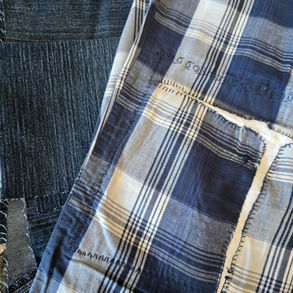craftraven

Quilt Mending
Mending a loved item thoughtfully can be very therapeutic. It also adds more value to the item because it becomes more personalized.
The Therapeutic Value of Mending a Quilt
Mending a quilt thoughtfully can be a therapeutic experience. It adds value to the quilt and personalizes it in meaningful ways. With every rip, tear, and hole you patch, you can consider how you are not beyond usefulness. You are treasured and worth the time and effort to restore. Here are some ideas on how to bring mindfulness to your quilt mending:
Thoughtful Ways to Personalize Your Quilt
Use Scraps from Your Fabric Stash: Incorporate fabric scraps that align with your aesthetic, creating a unique and visually appealing design.
[What do you have in your environment that you love? Does it have a place of honor it deserves so that it can bring you happiness every time you see it? Designing your personal space around the things that bring you joy is an easy way to boost your mental health.]
Repurpose Clothing: Utilize pieces from your clothing that are no longer wearable but hold sentimental value, allowing you to keep cherished memories alive.
[The advice to "just let it go" can sometimes be unrealistic. It can also be too difficult to follow. During a guided meditation, I was once told that if I couldn't let it go, at least set it down for now. I could always pick it back up later if I needed it. Some memories bring us happiness and some pain, and while trying to find our path in life, we don't always know which to keep and which to let go of. Consider setting them down. They can be heavy on your mind. Visualize a box or basket next to your chair or bed, and set your thoughts in it. Lighten your load and free your mind.]
Incorporate Loved Ones' Fabrics: Use fabric or clothing from a loved one who has passed away, adding a layer of emotional significance to your quilt.
[Grief can be incredibly challenging and complicated. The physical objects our loved ones acquire can be seen as "junk" that "just takes up space" while they're with us, but as soon as they are gone, those items can seem too precious to get rid of. If someone you cared about was a sewist or fabric artist, they likely left behind a fabric stash. Undoubtedly, your loved one left quite a few items of clothing. Stitching these into a quilt can help you process your loss, and using the quilt once it is complete can feel like getting a hug from your loved one.]
Through these mindful choices, mending a quilt can become a deeply personal and restorative activity, transforming it into a cherished heirloom filled with memories and stories.
The Mister and I purchased the quilt in this project just after our wedding. Materials I used included:
Fabric from my Mom (who is thankfully still with us)
Fabric from my Great Grandmother (who has been gone nearly 20 years and is still daily in my thoughts)
Thread from my Grandmother (she is still with us; however, dementia has stolen much of the identity I know her for having)
My jean material (I have many pairs that have been utilized for mending projects and thus many scraps perfect for just such a project as this)
A pair of The Mister's pajama pants, previously mended by myself and now worn beyond all hope of further repair (I found it amusing to reuse the patches I had placed on them previously that outlived the garment itself)
Lastly, a pair of my sibling's short pants (I kept every t-shirt and pair of pants that she owned; I could not bring myself to get rid of them)
The first things I tackled were the rips, tears, split seams, and worn-through places on the top of the quilt. These were so numerous that The Mister began referring to the project as "the gift that keeps on giving." He would ask, "How many are left?" I would reply, "At least one more."
I did not repair anything around the edges of the quilt, however. The entire edge was becoming so worn that I decided to cover the whole thing. And, as the underside of the quilt had significant damage, I knew I would be stitching an old sheet to the back for reinforcement. A new binding would cover the raw edges and save me some refinement work.
I didn't do the best job sewing the sheet to the underside of the quilt. There are places where it bunched up and others where I sewed down a fabric fold. I'm not fussed over it, however. No one will see these when the quilt is on the bed. Also, I am a recovering perfectionist. I have decided that I would rather do something imperfectly and finish the project than be so stymied by perfection that the project either takes much more time than I have to commit to it or I never tackle it.
Project Gallery
















